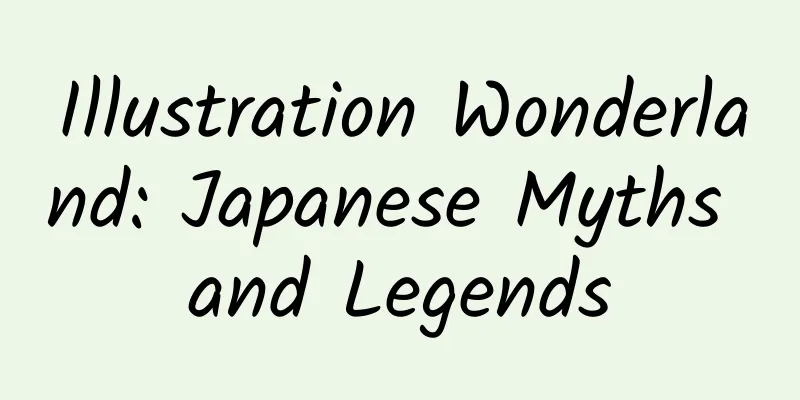Illustration Wonderland: Japanese Myths and Legends

|
Leviathan Press: We often say that we need to go out into the world. But where is this "world"? From a cultural perspective, communication (two-way) and output (one-way) are the main behaviors to achieve that "world (ism)". After all, if you want the "world" to understand you, you have to have quite decent and sophisticated cultural products. In this sense, Hasegawa Takejiro (1853–1938) did it. Now it seems that the reason why Hasegawa Takejiro was able to export Japanese mythology to the Western world is closely related to his "non-exclusive" thinking - this can be fully reflected in the composition of the text creators. Of course, the traditional core naturally needs the most local paradigm to be constructed, from the print form to the paper material, as well as the efforts to reconcile the overall publication expectations and realizations, so that "cultural products" are no longer an abstract term. Cover of the crepe paper version of Inaba no Hakuto, printed around 1911. © archive.org At the turn of the last century, the illustrated children’s books of the “golden age” provided readers with many unforgettable images: John Tenniel’s Alice in a blue apron looking up at the Cheshire Cat with a furtive smile, Walter Crane’s Belle in pink falling in love with the Beast with a boar’s head, and so on. Such masterpieces were generally thought to belong to the great publishers of London and New York. But on the other side of the world, at about the same time, Japan opened her ports to the world, and the Tokyo-based Kobunsha Publishing Company was about to make its own unique mark on children's illustrated books. Under the direction of Takejiro Hasegawa, the Japanese Mythology Series combined the work of Western writers, translators, and Japanese artists to capture the imagination of countless young readers. Published in 20 volumes between 1885 and 1922, Tales and Legends of Japan introduced traditional Japanese folk tales first to English and French readers, and then to German, Spanish, Portuguese, Dutch, and Russian readers. The sources of the stories were varied. The first book in the series, Momotaro, tells the centuries-old story of Momotaro. One day, an old couple finds a large peach by the river. They take it home and, opening it, are surprised to find a little boy inside. This is Momotaro, who the old couple raises until he leaves home and sets off on a series of adventures, returning as a local hero. The Boy Born in a Peach - Illustration from the second crepe paper reprint of Momotaro, circa 1889. © www.metmuseum.org Some books in the series adapted stories from the Buddhist tradition. In "The Stupid Jellyfish and the Clever Monkey," the jellyfish is teased by the monkey, punished by the Dragon King, and eventually loses its shell. It is based on another story in which the clever monkey is a bodhisattva in the process of enlightenment. The Dragon King sent a jellyfish to catch a monkey - Illustration from a crepe paper reprint of The Stupid Jellyfish and the Clever Monkey, circa 1911. © www.metmuseum.org Adapted by Lafcadio Hearn, The Boy Who Drew Cats tells the story of a daydreaming boy whose cats he draws on a temple wall magically defeat a mouse monster. In the traditional version, the boy becomes a devout monk. In Hearn's version, he becomes a famous artist. A page from the original 1898 crepe paper edition of The Boy Who Drew Cats. © digital.cincinnatilibrary.org Hasegawa Takejiro had hoped to sell Japanese Myths and Legends during the Meiji era in Japan, when the education industry was booming. The son of a merchant family that imported Western textbooks and other goods, Hasegawa was sent to English schools by his parents. This brought him into contact with many foreigners living in Japan, such as the Carrothers, a Presbyterian missionary couple who ran a private school from their home, who made him aware of the need for English textbooks in the country. He planned to produce new teaching materials, not only written by talented authors and translators, but also beautifully typeset by Japanese artists. The works Hasegawa published emulate the aesthetic of traditional Japanese anthologies. Beginning in the 16th century, Japanese publishers issued illustrated books of folk tales for children and adults, such as the stunningly beautiful Otogi Zoshi series, which brought together folk tales and narrative prose by a single author, and the Kunmeng Zuhui (Enlightenment Picture Collection) and Akabon, which contained fantastical stories of myths, monsters, and adventures. (Translator's Note: Akabon is a popular illustrated book for children published in Edo. Since the cover color of this type of book changed, it was gradually called Aobon or Kurobon.) Because literacy rates were low at the time, these books relied heavily on using a popular illustration style to portray the storyline for the reader, often with striking results. To recreate the effects of these early works, Hasegawa hired traditional Japanese woodblock printers and used traditional Mitsukoshi paper for his first books. As an early form of future industrialized printing, woodblock printing was introduced to Japan from the Song Dynasty in the 10th to 13th centuries and remained the mainstream printing technology in Japan until the 19th century. Compared to movable type printing, which could reuse individual characters on different pages, woodblock printing required printers to carve entire pages on a single board. Mitsukoshi paper was the most common Japanese paper at the time and was made from the kaempferia tree. During the Edo period, kaempferia was introduced to Japan for its excellent papermaking qualities. The stems of the kaempferia tree were cleaned of impurities and pressed into large barrels to create huge sheets of paper. The resulting paper was creamy white, strong and thick. The jealous old woman and the sparrow's gift to her - the second edition of The Tongue-Cut Sparrow printed on 1886 samura paper. © www.baxleystamps.com In terms of text, Hase commissioned three of his missionary friends: David Thomson, Basil H. Chamberlain, and Kate James, to translate the first readers of the stories. Reverend Thomson had come to Japan in the 1860s. He became fluent in Japanese and worked in a school run by the Carothers. He was influential in translating the Bible into Japanese, and when he chose the stories to translate, he focused on the moral teachings, which was not surprising given Victorian values about children's education. Basil H. Chamberlain was a British diplomat of aristocratic origin who earned a reputation as a Japanologist for his travelogues, ethnography, and other material about Japan. Chamberlain was more of a scholar than the other translators, being a professor at Tokyo Imperial University and having a keen interest in folklore. Chamberlain is the translator most familiar to readers, and he clearly contributed to the popularity of the stories. He even commissioned Hasegawa to publish a special set of Ainu myths because he was personally interested in the culture of the indigenous Ainu people of Hokkaido. Kate James translated the most books and, like Reverend Thomson, focused on stories with moral implications. However, she is a somewhat mysterious figure and little is known about her, except that she came from a Scottish clergyman's family, met her husband Thomas H. James in Constantinople, and they moved to Japan together and became friends with Basil H. Chamberlain, her husband's colleague at the Royal Naval College. The earliest versions of the Japanese mythology series were actually the work of this small, close-knit group of foreigners in Tokyo. Rice mortar, pestle, bee and egg join the crabs in a war meeting - illustration from the 1911 crepe paper reprint of The Battle of Monkey and Crab. © archive.org After the successful publication of the first edition of the stories in 1885, Hasegawa realized that there was a more lucrative market for foreigners than selling these myths to Japanese teachers and students. The artists who illustrated the stories: Kobayashi Eisei, Suzuki Hanason, and Toyohara Shuen were already famous for their ukiyo-e style woodblock prints, and Western readers were immediately drawn to their illustrations. In addition, as Japonism—the craze for collecting art and crafts from Japan—continued to grow, these woodblock prints became increasingly popular among Western enthusiasts. Beginning in 1895, perhaps with Japonism in mind, Hasegawa developed a special set of books that used a more decorative type of Japanese paper. Crepe paper, or crepe paper, is a fabric-like paper that is made by repeatedly and slowly rotating and squeezing paper fibers. The end result is a material that feels soft to the touch, but has a rough fold and leather-like texture that makes the illustrations printed on it look very old. In fact, part of Hasegawa's new marketing strategy was to present the books themselves as Japanese art and souvenirs. The ports around Yokohama Bay developed a number of foreigner enclaves that became meccas for visiting collectors seeking woodblock prints and related books. The books attracted international attention because of Hasegawa's efforts to promote them at world's fairs in Tokyo, Chicago, London, Paris, St. Louis, and Turin. The relationships he built at these fairs and the awards his books won kept demand for them going for more than a decade. Copyright page of the crepe paper edition of Songshan Mirror, circa 1911. © archive.org A ghost cat dancing outside the young samurai's window - two pages from a 1902 crepe paper reprint of The Legend of the Dog Siheitaro. © www.baxleystamps.com Night Parade of One Hundred Demons - Illustration from the 1910 crepe paper reprint of Umatori. © japanesefairytalse With ukiyo-e-style illustrations and new editions printed on crepe paper, Hasegawa's Japanese Tales and Legends series reached a wider audience in the West in the 1790s and early 20th century. Readers and critics alike loved these novel stories, which they found appealing to all ages. For example, one reviewer in the Japan Weekly Mail praised Kate James's language for being concise enough for young readers, but free of clichés that might detract from the adult reading experience. In the United States, the stories became popular enough to be reprinted in the widely circulated children's magazines Little Nicola and Ladies' Home Journal. Lafcadio Hearn and his family. © japanesefairytalse Also instrumental in Hasegawa's efforts to break into foreign markets was his assignment to the most famous figure associated with Japan at the time: Lafcadio Hearn. Born in Greece and raised in England, Lafcadio Hearn first rose to fame by writing about New Orleans and the French West Indies. He eventually moved to Japan, married a Japanese wife, and became a Japanese citizen. Because of his strong ties to Japan, he became an expert on Japanese culture and literature, publishing many books and stories about Japan for Western readers. Apparently, his essays for Hasegawa's second volume of stories boosted the popularity of the entire collection. Cover of a crepe paper reprint of The Nephilim, circa 1910. © digital.cincinnatilibrary.org The monk transforms into a Neti Bride and attacks the warrior with his web - illustration from a crepe paper reprint of The Neti Bride, circa 1910. © digital.cincinnatilibrary.org The Nephila is found and killed - illustration from a crepe paper reprint of The Nephila, circa 1910. © digital.cincinnatilibrary.org Japanese Tales and Legends received many positive reviews, but it was not universally praised. One reviewer for the Japan Weekly Post felt that while the writing was passable, the illustrations were unrealistic. He said the platemaker was lazy because he replaced the "authentic green" with odd yellow eyes. Other reviewers also felt that the illustrations were subpar. In the San Francisco Daily News, a particularly biased reviewer said the books were too "Japanese," "crude," and that the crepe paper was unsuitable for reading, making for "easily damaged" books. Fair critics share the misgivings about the suitability of crepe paper as do biased ones. In a letter to Hasegawa, Lafcadio Hearn objected to the rough texture of crepe paper and the corresponding reduction in visual detail: Really, I prefer the old Japanese Tales and Legends printed on plain paper—not only because the illustrations are better, but because the larger print is easier on children’s eyes. (I’m thinking of buying a plain paper set someday.) My own view is that the delicate beauty of the lovely pictures is lost in the crepe paper version—especially the lines of the old monk’s face, and the character of the peasant in the opening picture. Detail of the monk - original 1898 crepe paper edition of The Boy Who Painted Cats. © digital.cincinnatilibrary.org Ironically, the crepe-paper books continued to sell well, prized for their unique paper and illustrations, even after Hasegawa's books and other Japanese storybook series for children began to compete. American and British textbook authors also began to incorporate Japanese stories into their textbooks, reducing the novelty and uniqueness of the stories. The last book in the series, Lafcadio Hearn's rewrite of the fairy tale "The Fountain of Youth," was published in 1922 (although the publishing company continued to reprint it until after World War II). Looking back, we can see that the Japanese Tales and Legends series blends concise narrative and striking imagery with an elegance that rivals any of the more famous masterpieces of the golden age of children's illustrated books. At a time when publishers in London and New York dominated the market, Hasegawa's Tokyo-based publishing house produced equally beautiful books using traditional Japanese craftsmanship to spread Japanese culture to the world. Today, animation and manga represent thriving new art forms through which Japanese culture is transmitted to a global audience, but in the words of craft historian Ann Herring, "in the field of translation exports for young readers, the Meiji era record remains unmatched." By Christopher DeCou Translated by Miao Xin Proofreading/Miao Xin, Rabbit's Lingbo Weibu Original text/publicdomainreview.org/2019/09/03/woodblocks-in-wonderland-the-japanese-fairy-tale-series/ This article is based on the Creative Commons Agreement (BY-NC) and is published by Miao Xin on Leviathan The article only reflects the author's views and does not necessarily represent the position of Leviathan |
<<: Going inside rocks to explore the scientific mysteries of fluid inclusions
>>: Look! There’s an “ice cream” on the tree!
Recommend
A large area of coal mines in Inner Mongolia collapsed, and rescue was difficult! A picture to understand open-pit coal mines and safety production
Produced by: Science Central Kitchen Produced by:...
The latest news on Jilin’s lifting of lockdown in 2022: When is the lockdown expected to be lifted? Has the lockdown been lifted now?
Recently, the local epidemic in Jilin has attract...
Look! There are a group of prehistoric monsters "sealed" in the rocks!
The fantastic creatures that are difficult to dis...
Why are giants investing heavily in drone companies when there is no innovative breakthrough in technology?
At the 2016 CES, drones, VR/AR, electric vehicles...
New media planning and event operation tool library!
Marketing operations are inseparable from activit...
Middle-aged weight gain has nothing to do with metabolism! If you want to get rid of your "fat belly", follow these 3 dietary recommendations!
After entering middle age, "gaining weight&q...
Why HTC is in trouble: It's slowing down while the leaders are accelerating
Foreign media Arstechnica published an article th...
Is it difficult to upload an APP with a fake ID and pass the review? Teach you step by step to solve it from a technical level!
Event Introduction The 2016 WWDC Developer Confer...
Play with Android nested scrolling
In the process of Android UI development, we ofte...
Brand Advertising Development Trends in 2022
"In the real market environment, 70% of sale...
The first giant panda to go abroad was mistaken for a strange pug
More than a hundred years ago in the Western worl...
Don't wash vegetables like this, be careful that they will become dirtier and lose nutrients! Many people don't do it right
Vegetables are an indispensable part of our daily...
HTTPS vulnerability exposes 1,500 iOS apps to security vulnerabilities
SourceDNA, an app analytics service company, rele...
Ten tips for short video titles
Do you also have this kind of distress: after the...
Online earning sideline project, you will get income if you browse, you can do it all over the world
Online earning sideline project, there is income ...









